- Army
- Air Defense Systems
- Anti-tank systems and vehicles
- Armored Vehicles
- Armoured personnel carriers
- Artillery Vehicles and Weapons
- Command Post
- Communication Vehicles and Systems
- Electronic Warfare
- Engineer | Maintenance Vehicles
- Infantry Fighting Vehicles
- Main Battle Tanks
- Missiles
- Tactical and Logistic Vehicles
- Radars
- Unmanned Systems
- Weapons
- Navy
- Air
Rosomak 8x8 IFV APC
Rosomak 8x8 IFV APC
Rosomak wheeled armored vehicle - Poland
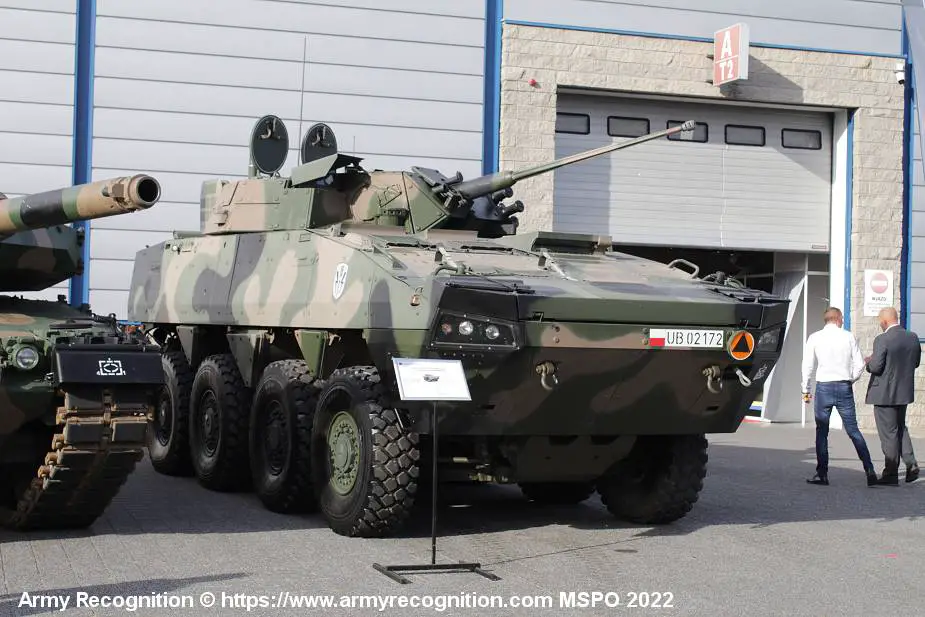
Description
The Rosomak 8x8 armored vehicle, also known as the KTO Rosomak (Kołowy Transporter Opancerzony Rosomak), is a Polish-made infantry fighting vehicle (IFV) designed to provide both transport and combat support for infantry units. The name "Rosomak" means "Wolverine" in Polish. Rosomak's development began in the late 1990s as a joint project between Poland and Finland, based on the Finnish Patria AMV (Armored Modular Vehicle) design. The Rosomak armored vehicle is produced and manufactured by a collaboration between two companies: Patria, a Finnish defense company, and Wojskowe Zakłady Mechaniczne (WZM), a Polish state-owned defense company. Patria was responsible for designing the vehicle, based on their Patria AMV (Armored Modular Vehicle) platform. WZM, also known as Zakłady Mechaniczne Tarnów, is responsible for the production and assembly of the Rosomak in Poland, as well as integrating various components, subsystems, and modifications specific to the requirements of the Polish Armed Forces and other potential customers.
The goal was to replace the aging Soviet-era BWP-1 infantry fighting vehicles used by the Polish Army. The first prototype was completed in 2001, and after a series of tests and modifications, the Polish Ministry of Defense awarded a contract to the Wojskowe Zakłady Mechaniczne (WZM) company in 2002 for the production of the Rosomak.
The Rosomak officially entered service with the Polish Army in 2004. Since then, it has undergone several upgrades and modifications to improve its capabilities, including enhanced armor protection, better situational awareness systems, and upgraded weapon systems. The vehicle has seen deployment in various international missions, including Polish-led operations in Iraq and Afghanistan, as well as NATO and European Union-led missions in the Balkans.
Poland remains the primary operator of the KTO Rosomak, but as the inaugural export customer of Patria, AMV & WZM SA holds the rights to export the KTO Rosomak in select markets. In July 2015, Poland signed a letter of intent with Slovakia for the sale of 30 Rosomak Wheeled Armored Vehicles, valued at $32 million. This agreement took place during the official visit of Slovak Prime Minister Robert Fico to Poland. The vehicles would be a hybrid of Polish armored modular vehicles, Rosomak, and a Slovakian gun turret. In April 2023, Polish President Andrzej Duda announced that Poland would supply Ukraine with 150 Rosomak 8x8 APC (Armored Personnel Carrier) vehicles.
Rosomak 8x8 armored vehicle variants:
- Rosomak IFV: Infantry fighting vehicle variant with an Oto Melara Hitfist-30P gun turret armed with a 30 mm ATK Mk 44 chain gun and 7.62mm NATO UKM-2000C machine gun. The turret has advanced fire control systems with thermal sights and an Obra laser warning system connected to six 81 mm 902A ZM Dezamet smoke grenade launchers.
- Rosomak-M2 and M3: Armored personnel carrier (APC) variants adapted for missions in Afghanistan, featuring similar task equipment and additional armor as the M1 variant. The main difference is the inclusion of an OSS-D open turret with either a 40 mm Mk-19 grenade launcher or a 12.7 mm NSW/WKM-B heavy machine gun.
- Rosomak-S: APC (Armored Personnel Carrier) variant designed for two anti-tank teams armed with Spike anti-tank guided missiles.
- Rosomak-WEM: (WEM for Wóz Ewakuacji Medycznej, meaning "medical evacuation vehicle") - Armored ambulance vehicle with a crew of three, capable of carrying three injured soldiers on stretchers and an additional four in sitting positions. The WEM-M variant, designed for Afghanistan, comes equipped with extra armor and RPGNet, similar to the M1M variant.
- Rosomak-WRT: (WRT for Wóz Rozpoznania Technicznego, meaning "technical reconnaissance vehicle").
- Rosomak-WSRiD: (WSRiD for Wielosensorowy System Rozpoznania i Dozoru, meaning "multisensory reconnaissance and supervision system").
- KTO Rosomak-Lowcza: Air defense command vehicle equipped with the Lowcza system.
- Rosomak-AWD: (AWD for Artyleryjski Wóz Dowodzenia, meaning "artillery command vehicle") - Command vehicle for the M120K Rak mortar company fire module.
- Rosomak-WD: (WD for Wóz Dowodzenia, meaning "command vehicle"). Command post armored vehicle.
- M120K Rak: 120 mm self-propelled mortar carrier armored vehicle, with the first vehicles delivered in July 2017.
- Rosomak-NJ: (NJ for Nauka Jazdy, meaning "driving school").
Technical Data
| Armament |
|
The Hitfist-30P turret, commonly used on the Rosomak Infantry Fighting Vehicle (IFV), is designed for a crew of two, consisting of a gunner and a commander. The weapon station is mounted in the center of the vehicle and houses the vehicle's primary armament, a 30mm ATK Mk44 Bushmaster II automatic cannon, and its secondary armament, typically a 7.62mm coaxial machine gun such as the UKM-2000. Additionally, the IFV is outfitted with Spike-LR Anti-Tank Guided Missile (ATGM) launchers. Armored Personnel Carrier (APC) variants of the Rosomak may have different armaments and turret types, including a one-man open turret that can be armed with one 12.7 mm heavy machine gun or a 40 mm grenade launcher, depending on the specific mission requirements.
In July 2022, The Polish MoD (Ministry of Defense) signed an agreement with a consortium led by the Polish company HSW S.A., and also involving the WB Group to equip the Rosomak IFV with the Polish-made ZSSW-30 unmanned turret. The turret is armed with one Mk 44/S Bushmaster II 30mm automatic cannon, capable of using ABM (Air Burst Munition) rounds and quickly converting to fire Super 40 rounds. Additionally, the turret features a dual Israeli-made Spike-LR/LR2 anti-tank guided missile launcher and a Polish-made UKM-2000C 7.62mm machine gun. The fire control system offers exceptional ergonomics and accuracy, allowing all weapons to be controlled from a single panel. The independent commander's observation system enables hunter-killer and killer-killer capabilities, further enhancing the vehicle's combat efficiency. |
| Design and protection |
|
The design of the Patria AMV comprises three main sections: the power pack is located at the front right of the hull, the driver is positioned at the front left, and the rest of the hull is reserved for the troop compartment. For the IFV version of the Rosomak, a two-person turret is centrally mounted on the hull. The AMV's hull is made of all-welded steel, providing protection against small arms fire and shell splinters. Additional passive armor can be added to enhance protection levels. Patria Vehicles asserts that the AMV's survivability is bolstered not only by its modular protection system but also by signature management and a defensive aids suite if installed.
The APC variant of the Rosomak has a crew of two, and the rear hull accommodates up to 10 soldiers. In contrast, the IFV version has a crew of three, including the driver, commander, and gunner, and carries eight soldiers. The troop compartment is situated at the rear of the hull, providing internal space for eight infantry soldiers equipped with its full gear equipment. The compartment is designed to offer a comfortable and safe environment for the troops during transportation and combat operations. The soldiers' seating arrangement in the troop compartment is typically four on each side, facing inwards. The seats are equipped with blast-attenuating technology to protect the occupants from the impact of landmines or improvised explosive devices (IEDs). Additionally, the compartment is climate-controlled, ensuring optimal temperature conditions for the soldiers during operations in various climates. For ease of entry and exit, the Rosomak IFV has a power-operated rear ramp door, which can also be used for emergency evacuation. This rear ramp door is equipped with a small hatch that can be opened independently, allowing troops to observe the surroundings, engage with hostile forces, or exit the vehicle without fully opening the ramp. There are also roof hatches for emergency egress, observation, or engaging with enemy forces from the top of the vehicle. |
| Mobility |
| The Rosomak armored vehicle is designed with a focus on mobility and versatility to operate effectively in various terrains and conditions. Its motorization is provided by a Scania DC12 12.7-liter diesel engine that delivers 360 to 543 horsepower, depending on the specific variant. This engine is coupled with an automatic transmission, typically a ZF Ecomat 7HP902, which has seven forward gears and one reverse gear. In terms of mobility capabilities, the Rosomak is an 8x8 wheeled vehicle that can achieve a top speed of around 100 km/h (62 mph) on roads. Its range is approximately 800 km (497 miles) on a single tank of fuel. The vehicle's independent suspension system, central tire inflation system, and run-flat tires allow it to traverse various terrains, including off-road, sand, snow, and mud. Its ground clearance can be adjusted to tackle different obstacles, and it can climb gradients of up to 60% and traverse side slopes of up to 30%. The Rosomak is also equipped with amphibious capabilities, allowing it to cross water obstacles such as rivers or lakes. In this mode, the vehicle can reach speeds of up to 10 km/h (6.2 mph), propelled by two water jets mounted at the rear of the hull. |
| Combat Equipment |
| The onboard combat equipment of the Rosomak armored vehicle varies depending on the specific variant, such as Infantry Fighting Vehicle (IFV) or Armored Personnel Carrier (APC). Generally, the Rosomak is equipped with modern and reliable communication systems that facilitate effective coordination between the crew, infantry, and other military units. This includes radio systems, intercoms, and data-sharing capabilities.
Additionally, the vehicle is fitted with advanced fire control systems and optics, which improve targeting accuracy and situational awareness during combat operations. These may include thermal imaging, laser rangefinders, and day/night vision capabilities. In some variants, the Rosomak features onboard defensive systems, such as smoke grenade launchers and active protection systems, to help protect the vehicle and its occupants from enemy fire and missiles. Furthermore, the vehicle can be fitted with a defensive aids suite and signature management systems to enhance its survivability. |
Specifications
| Armament | Armor |
| - Rosomak IFV: one 30mm ATK Mk44 Bushmaster automatic cannon, one 7.62mm coaxial machine gun and two launchers for anti-tank guided missiles. - Rosomak APC and other variants: One 12.7mm heavy machine gun or one 40mm automatic grenade launcher. |
All-welded steel, providing protection against small arms fire and shell splinters. Additional passive armor can be added to enhance protection levels. |
| Country users | Weight |
| Poland, Slovakia, Ukraine | 16,000 to 26,000 kg |
| Designer Country | Speed |
| Poland | 100 km/h |
| Combat Equipment | Range |
| Fire detection and suppression system, NBC system, air conditioning system, central tire inflation system, radios, intercom, and night vision equipment. | 800 km |
| Crew | Dimensions |
| - Rosmak IFV: 3 + 8 soldiers - Rosomak APC: 2 + 10 soldiers |
Length: 7.7 m; Width: 2.8 m; Height: 2.3 m |
Details View
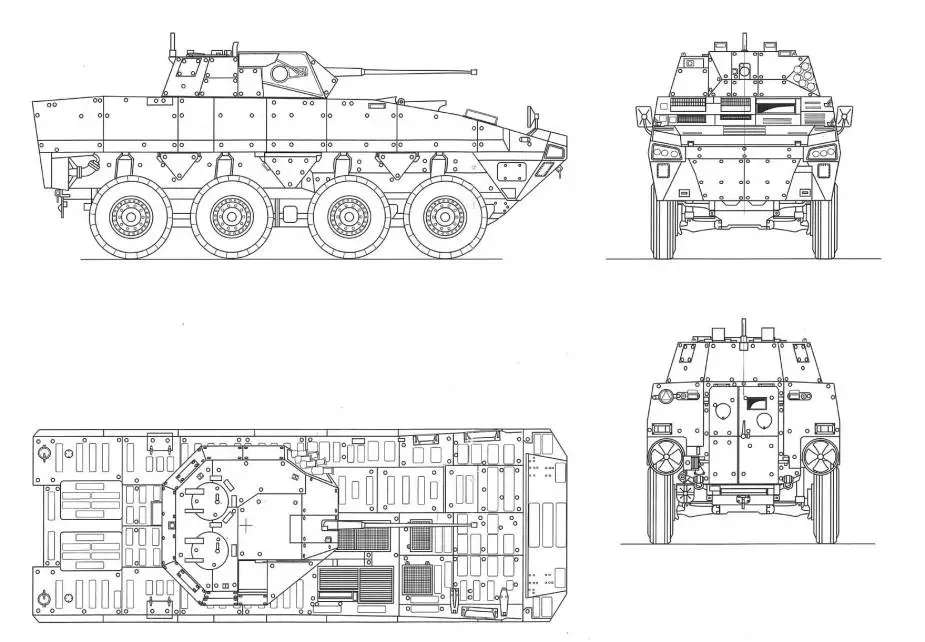 |
|
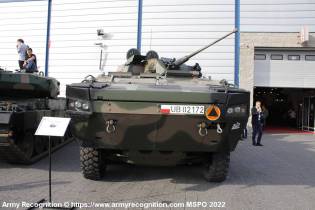 |
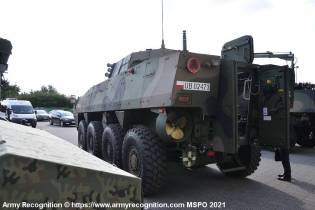 |
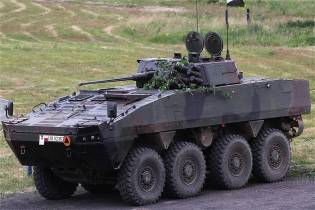 |
 |
Pictures - Video



























